[Amended 7-22-1993 by Ord. No. 531-93]�
A. The estimated costs of the off-tract improvement allocated to the applicant, if deposited in cash, shall be paid by the applicant to the Township Treasurer, who shall provide a suitable depository therefor, and such funds shall be used only for the off-tract improvements for which they are deposited or improvements serving the same purpose, unless such improvements are not initiated by the Township within a period of 10 years from the date of payment, after which time said funds so deposited shall be returned.�
B. In the event that the payment by the applicant to the Township Treasurer provided for herein is less than its share of the actual cost of the off-tract improvements, then it shall be required to pay its appropriate share of the cost thereof.�
C. In the event that the payment by the applicant to the Township Treasurer provided for above is more than its appropriate share of the actual cost of installation of the off-tract improvements, it or its successor or assigns shall be repaid an amount equal to the difference between the deposit and its share of the actual cost.�
D. Where a developer pays the amount determined as his pro rata share under protest, he shall institute legal action within one year of such payment in order to preserve the right to a judicial determination as to the fairness and reasonableness to such amount.�
Upon receipt from the applicant of its allocated share of the costs of the off-tract improvements, the Township may adopt a local improvement assessment ordinance for the purpose of construction and installation of the off-tract improvements based upon the actual cost thereof. Any portion of the cost of the improvements not defrayed by a deposit by the applicant may be assessed against benefiting property owners by the Township. Any assessments for benefits conferred made against the applicant or his successors in interest shall be first offset by a pro rata share credit of the allocated costs previously deposited with the Township Treasurer pertaining thereto. The applicant or his successors in interest shall not be liable for any part of an assessment for such improvements unless the assessment exceeds the pro rata share credit for the deposit, and then only to the extent of the deficiency.�
�
A. Credit for work performed. In the event that the applicant, with the Township's consent, decides to install and construct the off-tract improvement, or any portion thereof, the certified cost shall be treated as a credit against any future assessment for that particular off-tract improvement, or portion thereof, constructed by the Township in the same manner as if the applicant had deposited its apportioned cost with the Township Treasurer, as provided herein.�
B. Installation of improvements by applicant.�
(1) The Township may enter into a contract with the applicant, providing for the installation and construction of the off-tract improvements by the applicant upon contribution by the Township of the remaining unallocated portion of the cost of the off-tract improvement.�
(2) The portion contributed by the Township shall be subject to possible certification and assessment as a local improvement against benefiting property owners in the manner provided by law, if applicable.�
[Added 5-9-1988 by Ord. No. 367-88]�
General requirements in the Critical Geologic Formation Zone. For all development proposals in the Critical Geologic Formation Zone, whether residential or nonresidential, a geologic investigation program to determine the potential for development shall be prepared and conducted in accordance with the requirements of § 165-72C. The geologic investigation program shall be designed to produce information and provide recommendations for site planning and engineering design and construction techniques which shall meet or exceed the standards of the geology study provisions of the geologic segment of the EIS (§ 165-72). The geologic segment of the EIS may be completed and filed prior to the completion of the other portions of the EIS at the applicant's option.�
A. General. The applicant shall observe the following requirements and principles of land subdivision in the design of each subdivision or portion thereof:�
(1) Development pattern. The subdivision plat shall conform to design standards that will encourage good development patterns within the Township.�
(2) Conformance to Master Plan and Official Map. Where either or both an Official Map or Master Plan has or have been adopted, the subdivision shall conform to the proposals and conditions shown therein. The streets, drainage rights-of-way, school sites, public parks and playgrounds shown on an officially adopted Master Plan or Official Map shall be considered in the approval of subdivision plats.�
B. Streets.�
(1) The arrangement of streets not shown on the Master Plan or Official Map shall be such as to provide for the appropriate extension of existing streets.�
(2) All streets shall have rights-of-way and pavement widths sufficient to carry anticipated traffic, but in no event shall the right-of-way be less than shown on the Master Plan or Official Map. All streets shall be designed in accordance with the requirements of § 165-73, Roads and Improvements, of this chapter and in accordance with the Schedule to this Article XI.�
(3) Marginal access. In subdivisions that abut arterial streets and such other streets or portions of streets as the Planning Board may designate on the Master Plan, the Planning Board may require provision for marginal access roads, reverse frontage lots with buffer strips for planting or other design methods for the purpose of separating through and local traffic.�
(4) Right-of-way width. The right-of-way width shall be at least 50 feet unless a greater width is shown on the Master Plan or Official Map.�
(5) No subdivision showing reserve strips controlling access to streets shall be approved except where the control and disposal of land comprising such strips has been placed in the Township Council under conditions approved by the Planning Board.�
(6) Subdivisions that adjoin or include existing streets that do not conform to widths as shown on the Master Plan or Official Map or the street width requirements of this chapter shall dedicate additional width by easement along either one or both sides of said road. If the subdivision is along one side only, 1/2 of the required extra width shall be conveyed by easement to the Township. Portions of existing streets on which the subdivision fronts shall be improved in accordance with the Township Road and Improvement Ordinance and in accordance with the Schedule to this Article XI.�
(7) Grades of arterial and collector streets shall not exceed 8%. Grades on other streets shall not exceed 10%. No street shall have a minimum grade of less than 1% or as approved by the Planning Board.�
(8) Street intersections shall be at right angles. The block corners at intersections shall be rounded at the property line and have a radius of not less than 25 feet.�
(9) Street jogs with center-line offsets of less than 125 feet shall be prohibited.�
(10) A tangent at least 100 feet long shall be introduced between reverse curves on arterial and collector streets.�
�
(11) When connecting street lines deflect from each other at any one point by more than 10 degrees and not more than 45 degrees, they shall be connected by a curve with a radius of not less than 100 feet for minor streets and 300 feet for arterial and collector streets.�
(12) All changes in grade shall be connected by vertical curves and shall provide a smooth transition and proper sight distance.�
(13) A dead-end street or cul-de-sac intended to serve one- and two-family dwellings shall not exceed 1,500 feet in length nor serve more than 24 lots. Dead-end streets shall have a turnaround at the end with a radius of not less than 63 feet to the right-of-way line and tangent whenever possible to the right side of the street. If a dead-end street is of a temporary nature, a similar turnaround shall be provided and provisions made for future extension of the street and reversion of the excess right-of-way to the adjoining properties.�
(14) No street shall have a name which will duplicate or so nearly duplicate as to be confused with the names of existing streets. [Amended 5-27-1993 by Ord. No. 516-93]�
C. Blocks.�
(1) Block length and width or acreage within bounding roads shall be such as to accommodate the size of lot required in the area by the zoning regulations and to provide for convenient access, circulation control and safety of street traffic.�
(2) Pedestrian crosswalks may be required in blocks in locations deemed necessary by the Planning Board. Such walkways shall be 10 feet wide and be straight from street to street.�
(3) For commercial, group housing or industrial use, block size shall be sufficient to meet all area and yard requirements for such use.�
D. Lots.�
(1) Dimensions. Lot dimensions and area shall be not less than the requirements of the zoning regulations.�
(2) Side lines. Insofar as practical, side lot lines shall be at right angles to straight streets and radial to curved streets.�
(3) Frontage. Each lot must front upon an approved street at least 50 feet in width.�
(4) Setbacks. Where extra width has been dedicated for widening of existing streets, lots shall begin at such extra-width line, and all setbacks shall be measured from such line.�
(5) Suitability. All lots shall be suitable for their intended uses and, where necessary, increased in size to compensate for conditions such as steep slopes, rock formations and flood conditions.�
�
E. Public use and service areas.�
(1) Easements. In large scale developments, easements along rear property lines or elsewhere for utility installations may be required. Such easements shall be at least 15 feet wide and located in consultation with the companies or Township departments concerned.�
(2) Drainage - easements. Where a subdivision is traversed by a watercourse, drainageway channel or stream, there shall be provided a stormwater easement or drainage right-of-way conforming substantially to the lines of such watercourse and such further width or construction, or both, as will be adequate for the purpose.�
(3) Natural features. Natural features such as trees, brooks, hilltops and views shall be preserved whenever possible in designing any subdivision containing such features.�
F. [Repealed 5-27-1993 by Ord. No. 516-93]�
G. [Repealed 5-27-1993 by Ord. No. 516-93]�
H. Energy conservation. All subdivisions shall, to the greatest degree possible, follow , energy-efficient design principles and maximize the use of renewable energy sources. Within the limits of practicability and feasibility, the criteria listed below shall be followed.�
(1) Streets. Streets shall be so oriented as to permit the buildings to be constructed thereon to maximize solar gain. Where possible, streets shall run in an east-west direction.�
(2) Lots. Lots shall also be oriented as to permit buildings to be constructed thereon to maximize solar gain. Where possible, the long access of a lot shall run in a north-south direction.�
(3) Topography. The development shall take advantage of topographic features to maximize solar gain and afford protection from winter winds. Where possible, development shall be oriented to southerly slopes.�
(4) Vegetation. Maximum use shall be made of natural vegetation which will afford protection from winter winds and provide shading in summer.�
A. General. In general, site plans shall follow the principles of design relating to subdivisions where applicable. In reviewing said site development plans, the Planning Board shall ascertain that the following requirements are complied with:�
(1) The provisions of the zoning regulations with respect to height, minimum lot areas, mandatory open spaces and the like are complied with.�
(2) Adequate provision is made for off-street parking in accordance with Subsection A(10) below, and adequate traffic circulation, traffic safety and protection to adjoining property is provided. Each parking space shall contain at least 180 square feet with a minimum width of nine feet measured perpendicular to the axis of the length and a minimum length of 20 feet. However, the minimum size of the parking space may be reduced to 162 square feet with a minimum width of nine feet, measured perpendicular to the axis of the length and with a minimum length of 18 feet if a bumper overhang area of two feet in depth is provided, which does not encroach upon any required sidewalk or a parking divider of less than four feet width. [Amended 11-23-1987 by Ord. No. 350-87; 12-14-1987 by Ord. No. 355-87]�
(3) Adequate provision is made for the disposal of stormwater as approved by the Township Engineer. In addition, the requirements of the Clinton Township Surface Water Management Ordinance shall be met.�
(4) The location, design or construction of any building is not likely to involve risks of traffic congestion, public safety or hazard.�
(5) The design or construction of any building or use will not be so markedly incongruous with the character of the neighborhood as to materially affect the value of adjacent or nearby property.�
(6) Lighting shall be designed in accordance with § 165-74. [Amended 4-26-2000 by Ord. No. 718-00]�
(7) All parking areas shall provide for adequate ingress and egress and safe and convenient traffic circulation. Access drives and aisles shall be of sufficient width to permit safe access to parking spaces and safe traffic movement. Driveways leading to common parking areas, exclusive of driveways serving only one dwelling unit, whether attached or detached shall not be less than 75 feet from any street intersection nor 20 feet from another driveway, measured along the curbline. In addition, except as provided in Subsection B of this section, all off-street parking and loading areas, except for parking which is accessory to one-family dwellings, shall, unless otherwise provided by this chapter, meet the location requirements prescribed in the following schedule: [Amended 11-23-1987 by Ord. No. 350-87; 10-22-1990 by Ord. No. 436-90; 6-14-2006 and 9-13-2006 by Ord. No. 908-06]�
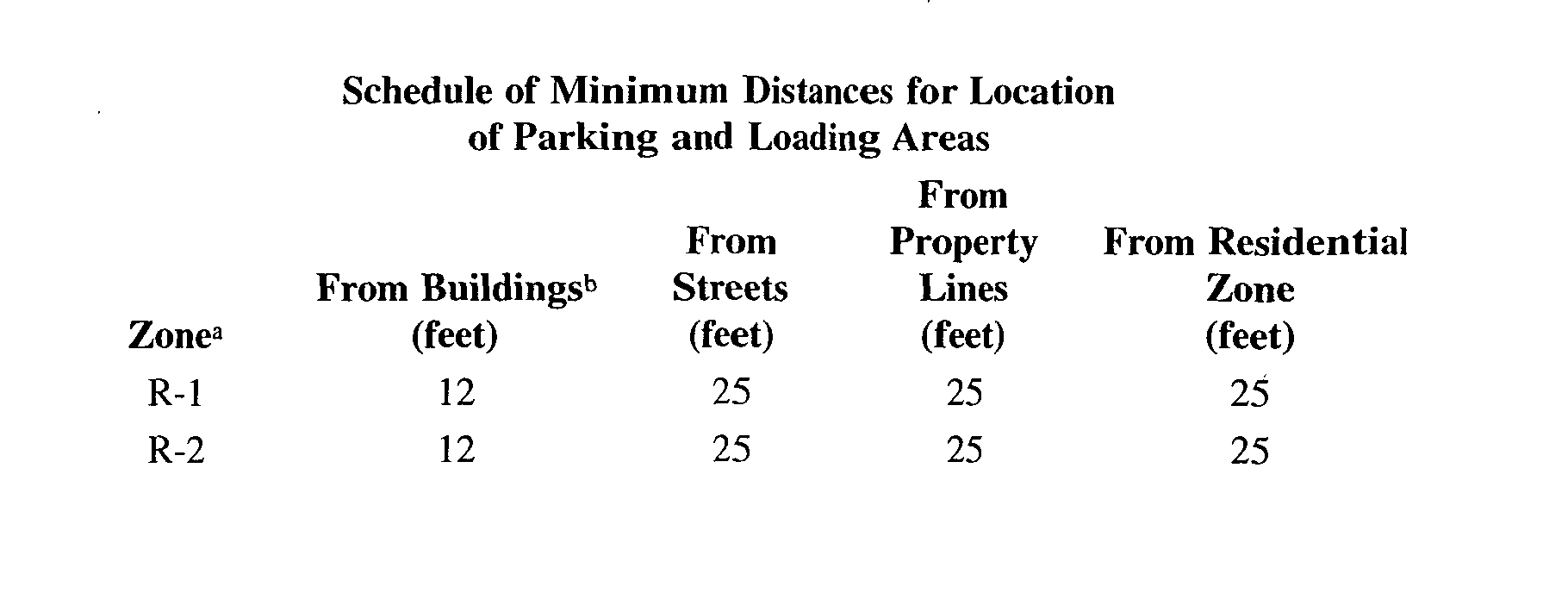
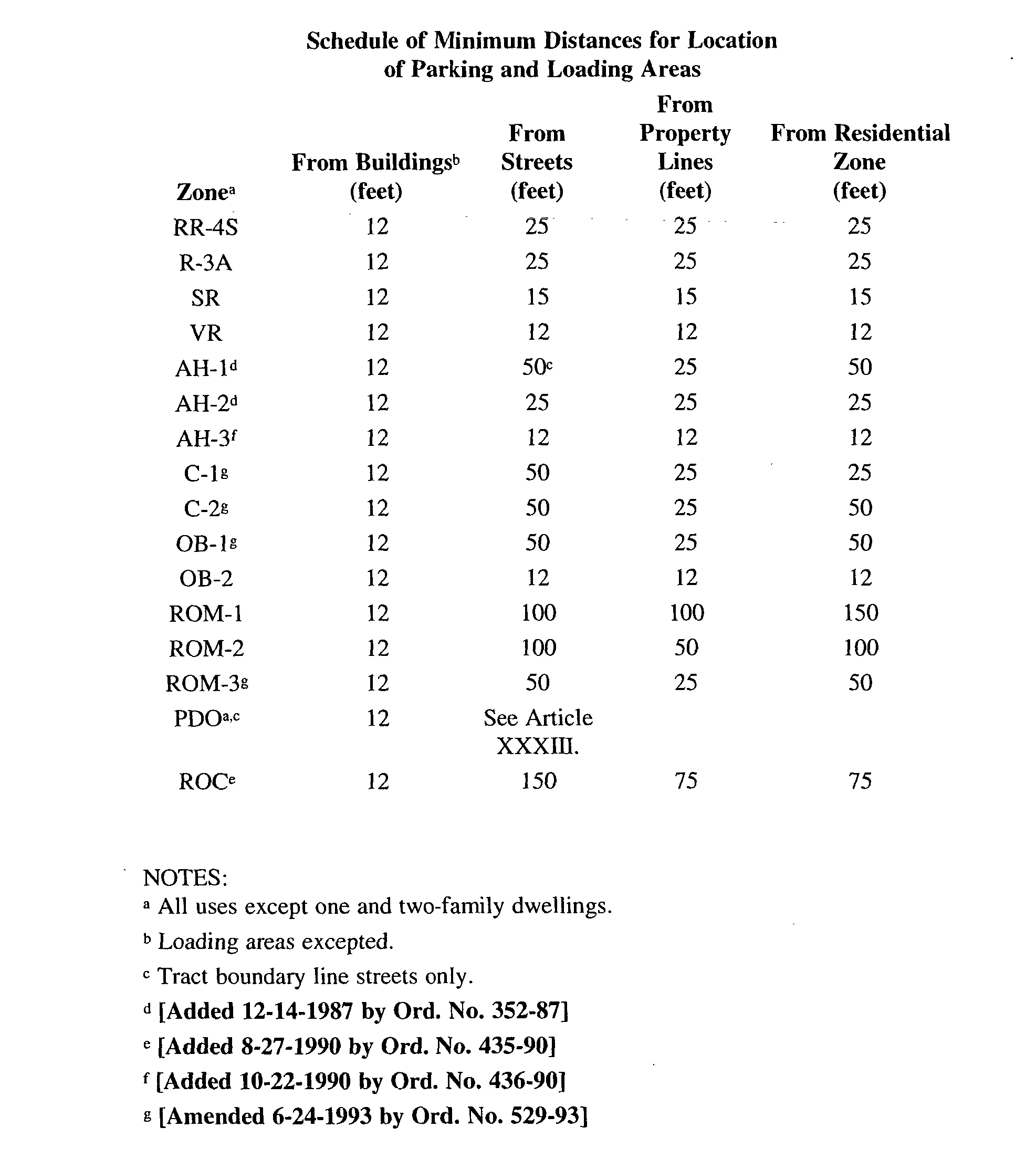
(8) Off-street parking areas shall be used solely for the parking of passenger automobiles, and no commercial repair work or service of any kind shall be conducted on the parking lot, nor shall such lots be used for the parking of disabled, dismantled, inoperable or unregistered vehicles.�
(9) Parking service aisles.�
�
(a) All parking areas shall be designed with service aisles to meet the following standards:�
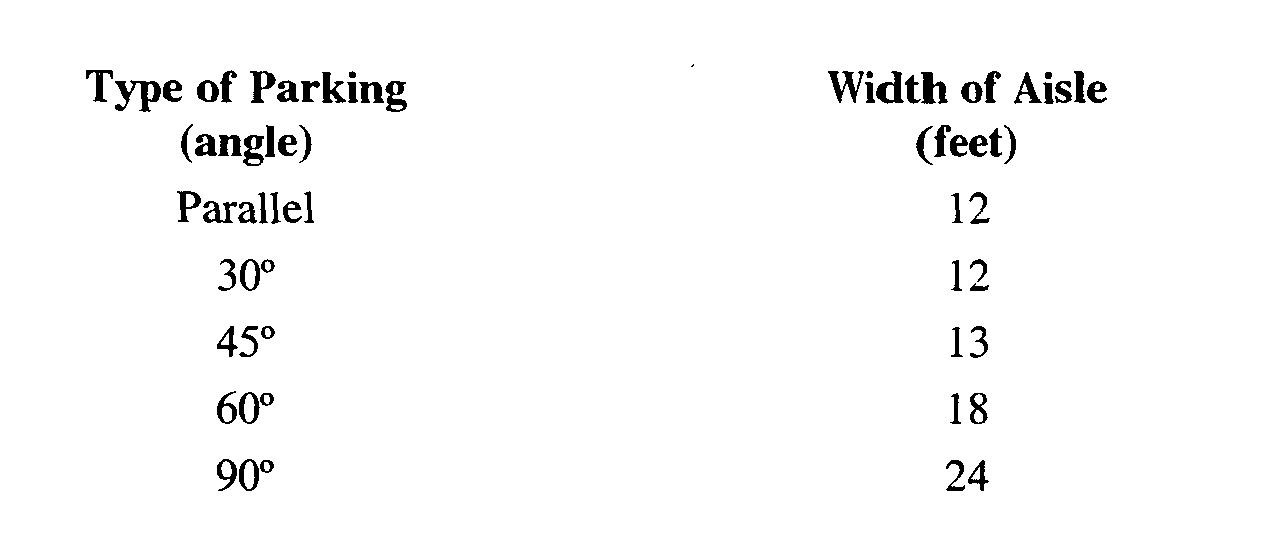
(b) In addition, there shall be a minimum distance between parallel parking spaces of six feet when found necessary to provide for convenient access.�
(10) Off-street parking requirements.�
(a) For all new buildings or uses or additions to existing buildings or uses in all zone districts, there shall be provided the number of parking spaces required by the specific use, as prescribed in the following schedule:�
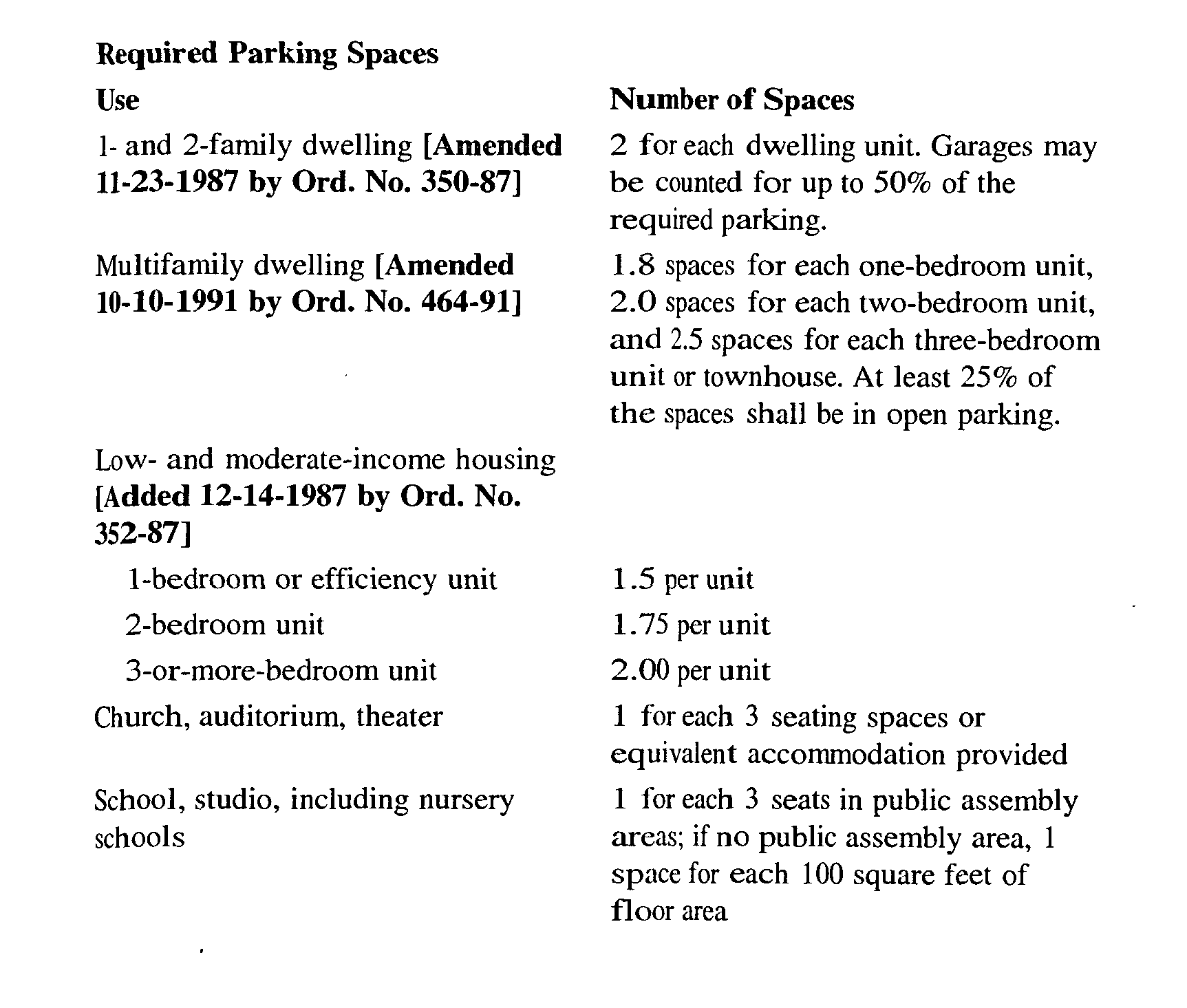
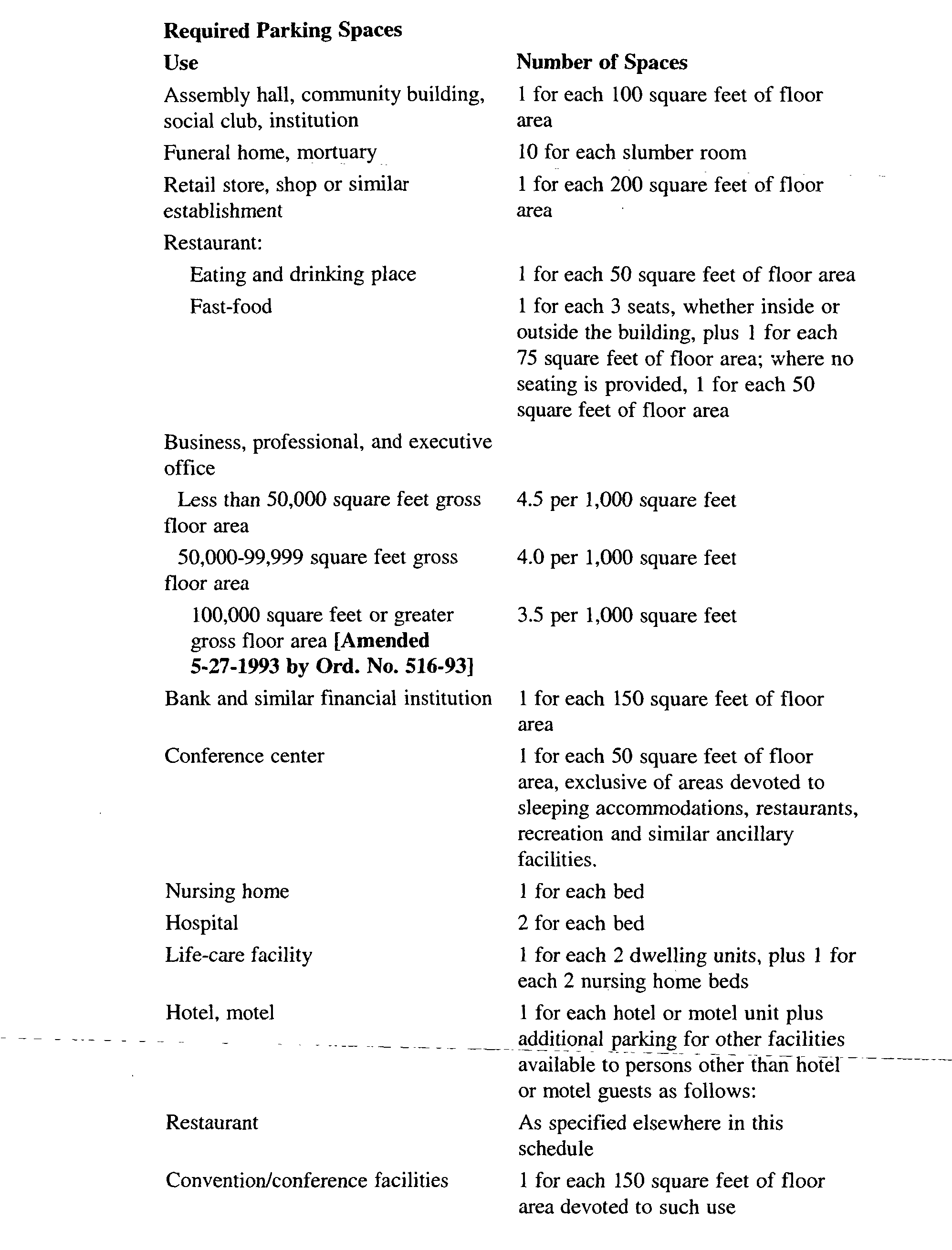
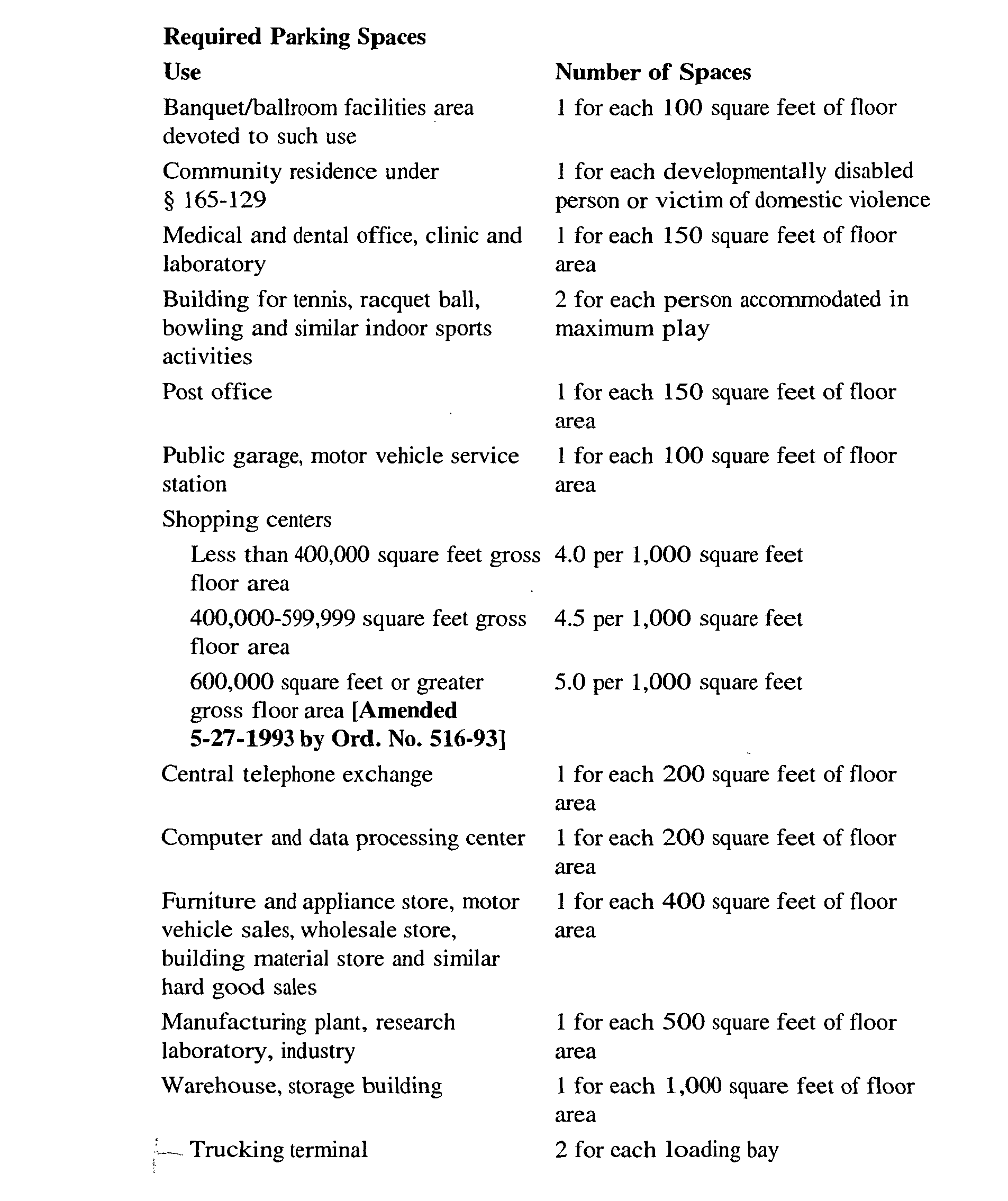
(b) Any building containing more than one use shall meet the combined parking space requirements for all uses in the building. Any change in use within a building shall be required to meet the minimum parking requirements for the new use.�
(c) Parking space requirements for a use not listed above shall be determined by the Planning Board on the basis of requirements of similar uses and on the basis of the specific nature of the use. In addition, the Planning Board shall have the authority to require a greater number of parking spaces than required above or the reservation of area for additional future parking if, due to the nature of the use, a greater number of spaces is likely to be needed now or in the future.�
(d) If it can be clearly demonstrated that because of the peculiar nature of any use, all the required parking is not necessary, the Planning Board may permit a reduction in the amount of parking area to be paved; provided, however, that the entire required parking area shall be shown on the site plan so that it will be available in the event future conditions should so require.�
(11) Off-street loading. In all districts, for every building or use requiring the receipt or distribution in vehicles of materials or merchandise, there shall be maintained on the same premises with such building or use at least one off-street loading space.�
(a) Each loading space shall be at least 14 feet in width, 60 feet in length and have a sixteen-foot clearance above grade.�
(b) Such space shall be located in the side or rear yard only, but in no case in a side yard adjoining a street.�
(12) The provisions of this chapter pertaining to screening and landscaping as contained in § 165-63F and H shall be complied with.�
(13) For all nonresidential uses, provision shall be made for the orderly deposit, storage and collection of trash, garbage and other waste material. Any trash, garbage and waste material stored outside of buildings shall be stored in suitable containers and in fenced or walled enclosures. Said enclosures may adjoin the rear wall of a building or a side wall of a building which does not face on either a street or a residential district or may be located in the rear yard and apart from the building, provided that all accessory building setbacks are met. Said enclosures shall be screened from view from any adjoining street or property when deemed necessary by the Planning Board. Any trash, garbage and waste material shall be so contained as to be protected from the elements and to eliminate potential for accumulation or scattering of debris. Garbage of an animal or vegetable nature, any trash or waste material that would attract vermin and insects and any other waste material which, by its nature, would present a health hazard if exposed to the elements shall be stored in airtight and/or leakproof, covered metal containers as may be necessary.�
(14) All other applicable provisions of this chapter are met.�
(15) The applicant has obtained necessary approvals of any state, county or municipal agencies.�
(16) The Planning Board shall give consideration to such other elements or aspects of the site plan or proposed use as may relate to the design of the plan, the general environment of the area or the health, safety and general welfare of the public.�
B. Planned development site plan. In the case of a site plan for a planned development, including multifamily dwellings, review of the site plan shall consider the following criteria:�
(1) General findings.�
(a) The proposals for maintenance and conservation of the open space are reliable, and the amount, location and purpose of the open space are adequate.�
(b) Provision through the physical design of the proposed development for public services, control over vehicular and pedestrian traffic, and the amenities of light and air, recreation and visual enjoyment are adequate.�
(c) The proposed development will not have an unreasonably adverse impact upon the area in which it is proposed to be established.�
(d) In the case of a proposed development which contemplates construction over a period of years, that the terms and conditions intended to protect the interests of the public and of the residents, occupants and owners of the proposed development in the total completion of the development are adequate.�
(2) Parking and circulation.�
(a) All off-street parking areas and internal roadways shall be paved, bounded by permanent curbing and constructed in accordance with applicable provisions of § 165-73, Roads and Improvements, of this chapter, and in accordance with the Schedule to this Article XI.�
(b) Parking areas and internal roadways shall be located at least 15 feet from a building, unless a driveway leading to a garage, at least 50 feet from a tract boundary line and at 25 feet from a street.�
(c) Parking spaces or driveways serving individual dwelling units shall not be entered directly from a public street,�
(d) Internal roadways shall be at least 20 feet in width for two-way traffic and 12 feet in width for one-way traffic and shall not enter a public street within 100 feet of an intersection. Parking in internal roadways shall be prohibited.�
(e) The arrangement and location of garages, parking areas and internal roadways shall be subject to approval of the Planning Board and shall be designed to ensure maximum safety, proper circulation and maximum convenience for residents and their guests. Dead-end roadways and driveways serving multifamily housing shall not exceed 1,500 feet in length. Large expanses of pavement and long, unbroken rows of parking spaces shall be avoided. Adjoining rows of parking spaces shall be separated by landscaped islands having a width of at least 10 feet, and no row of parking spaces shall contain more than 15 spaces unless broken by landscaped islands. Parking areas exceeding 10,000 square feet in area shall incorporate landscaped areas within them, said landscaped area amounting to at least 10% of the parking area. The parking area shall be determined by the outer limit of pavement on the site and the inner limit of pavement around or adjacent to the building.�
(3) Buffer zone requirements. Buffers and landscape design shall be in accordance with § 165-77. [Amended 6-13-2007 by Ord. No. 923-07]�
(4) Building design. The design of all buildings shall be such as to enhance the quality and character of the area. All buildings shall be visually related to the terrain and to each other so as to create both visual harmony and functional variety. Such objectives shall be accomplished through measures such as the following:�
(a) Staggering of walls of building facades.�
(b) The use of architectural designs which are harmonious and compatible.�
(c) The use of exterior colors and roof and facade materials or a combination of colors and materials that are coordinated.�
(d) Sensitive use of roof heights, roof and wall projections, building mass, lengths, widths and directions and ornamental features to create both variety and function.�
�
(e) Clustered arrangement of smaller buildings as opposed to single, large buildings on a site is encouraged. No building intended for retail trade, banks and offices shall have a ground floor area exceeding 40,000 square feet, nor shall the length or width of any such building exceed 200 feet.�
(5) Landscape design. [Amended 6-13-2007 by Ord. No. 923-07]�
(a) Landscape design shall be in accordance with § 165-77.�
(b) Hardsurfaced sidewalks at least four feet in width shall be provided in such locations as will ensure convenient pedestrian traffic as required by the Planning Board.�
(c) Plantings and/or fencing shall be provided, where necessary, adjoining parking facilities, swimming pools and similar activity facilities in order to screen them from the view of adjoining streets and residential development.�
(d) Adequate artificial lighting shall be provided in parking areas and along sidewalks, walkways and internal roadways. The direct source of lighting shall not be visible from buildings, adjoining streets and property lines.�
(6) Utilities.�
(a) All utility systems shall be designed in accordance with accepted engineering practices and with all applicable municipal and state regulations.�
(b) All new telephone and electric service on the property shall be underground.�
(c) All trash and garbage shall, be stored at all um ies in covered containers which shall be kept in centrally located, concealed areas.�
(7) Developments in the AH Districts. The design standards below shall apply to developments in the AH-1 and AH-2 Districts, which include provisions for affordable housing. [Added 12-14-1987 by Ord. No. 352-87]�
(a) Distribution of dwelling unit types in the AH-1 District. In the AH-1 District, the total number of dwelling units shall be distributed among the various dwelling unit types based on the following guidelines:�
[1] One-family detached dwellings: 30%o maximum.�
[2] One-family detached and two-family dwellings: 35% maximum.�
[3] Townhouses: 20% minimum, 60% maximum.�
[4] Apartments: 60% maximum. [Amended 10-10-1991 by Ord. No. 464-91]�
(b) Maximum number of dwelling units per buildings.�
[1] Townhouses. No townhouse building shall contain more than eight dwelling units, and not more than 50% of the townhouse buildings shall contain more than six townhouse dwelling units.�
[2] Apartments. No apartment building shall contain more than 24 dwelling units, and the average number of dwelling units per apartment building shall not exceed 20, in the aggregate, apartment units.�
(c) Minimum distances between buildings. For townhouse and apartment buildings, the minimum distance between buildings, and between buildings and internal roads or rights-of-way, shall be as follows:�
[1] End wall to end wall: 35 feet.�
[2] Rear wall to rear wall: 50 feet.�
[3] Front wall to front wall: 65 feet.�
[4] A front wall is defined as one which faces a street or parking area.�
(d) Building design. Architectural design and materials used in the construction of accessory buildings shall conform to those used in the construction of principal buildings.�
(e) Open space and recreation. At least 50% of the site, exclusive of areas devoted to commercial development, shall be open space as defined herein. This open space shall include at least 20% of the site in common open space and recreation facilities.�
C. Nonresidential site plans. Site plans for nonresidential uses in all nonresidential zones except the C and OB-2 Zones shall adhere to the following design and performance criteria:�
(1) Standards for development in critical areas.�
(a) Coverage by impervious surfaces of prime aquifer recharge soils shall be avoided wherever possible. Not more than 50% of the prime aquifer recharge areas on any lot shall be covered by buildings and other impervious surfaces. Prime aquifer recharge areas are identified in the Natural Resources Inventory.�
(b) Development in areas of slope exceeding 25% is prohibited.�
(c) Coverage by buildings and other impervious surfaces of slopes ranging from 15% to 25% shall not exceed 50% less one percentage point for each acre or part thereof of lot area greater than five acres, provided that under no circumstances need the maximum coverage of such slopes be less than 25%.�
�
(d) Development in flood hazard areas shall be as regulated in Chapter XV of the Township Code. In addition, there shall be no development by buildings and other impervious surfaces in a delineated floodway. In flood-fringe areas, development shall be limited to pavement and similar impervious surfaces. Coverage by such impervious surfaces of the flood-fringe area shall not exceed 25%.�
(2) The anticipated water demand from on-site groundwater sources of any proposed development shall not exceed the safe groundwater yield for the site based on geologic formations within the property boundaries and as determined by the New Jersey Bureau of Geology. Anticipated available groundwater yields for various geologic formations in Clinton Township are shown on Page 10 of the Master Plan Re-examination Report dated October 1982.�
(3) Developers are encouraged to keep impervious surfaces to a minimum and employ such measures, including car and van pooling, as will justify reduction in the amount of parking area to be paved in accordance with § 165-71A(10)(d).�
(4) Any street serving the development and any nearby street providing access for the development to major access routes shall have a level of service during peak hours of better than "C" following establishment of the development. The Planning Board may require improvements to such streets if the proposed development will cause the level of service to reach "C" or greater. "Level of service" is defined in the Highway Capacity Manual, Special Report No. 87, Highway Research Board.�
(5) The maximum ground floor area of any building shall not exceed the lesser of the maximum permitted building coverage or five acres.�
D. Site maintenance. All buildings, paved areas and landscaping shall be adequately maintained and shall be kept clean and free from debris at all times. Dead trees or shrubs shall be replaced by the owner. Failure of the owner to comply with these provisions within six months of notification by the Construction Official shall be considered a violation of this chapter.�
E. Energy conservation. All site plans shall, to the greatest degree possible, follow energy efficient design principles and maximize the use of renewable energy sources. Within the limits of practicability and feasibility, the criteria listed below shall be followed.�
(1) Buildings shall be oriented to maximize solar gain. Where possible, building walls with the greatest number of windows or window area shall face in a southerly direction. The use of active and passive solar energy gain systems in buildings is encouraged.�
(2) Buildings shall be arranged to provide maximum protection to each other in terms of energy consuming elements.�
(3) The use of energy efficient building materials and colors is encouraged.�
(4) Site arrangement shall take advantage of topographic features to maximize solar gain and afford protection from winter winds.�
(5) Natural vegetation and landscaping, including fences, walls and earthworks, shall be utilized to maximize protection from wind and channel breezes and shade buildings and pavement.�
(6) The site shall be designed to minimize pavement and afford efficient circulation. The use of footpaths and bike paths in multifamily housing developments, in order to reduce motor vehicle use, is encouraged.�